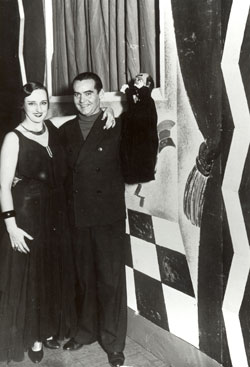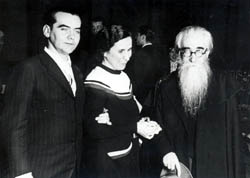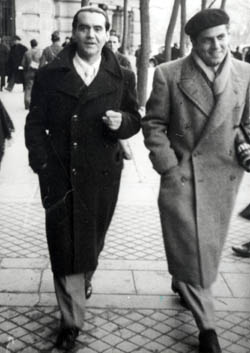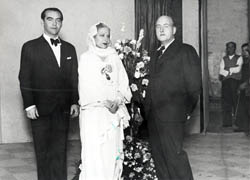|
 |
|
|
On 29 SEPTEMBER, on board the Conte Grande, the poet sets sail from Barcelona to Buenos Aires. With him on board is the stage manager Manuel Fontanals. After ports of call in Las Palmas (Canary Islands), Río de Janeiro and Montevideo, they arrive in Buenos Aires on 13 October. En route, however, Federico is able to work on Yerma and on the conference “Juego y teoría del duende”. The two friends stay at the Hotel Castelar, in the Avenida de Mayo, and the press takes vivid note of the poet´s visit. He is an active participant in the social life of Buenos Aires, and makes friends with many a writer and artist: Oliverio Girondo, Pablo Neruda, Ricardo Molinari, Victoria Ocampo, Jorge Larco, Norah Lange, Amado Villar, Salvador Novo… His conferences address the topics "Juego y teoría del duende, Cómo canta una ciudad de noviembre a noviembre, Un poeta en Nueva York, El cante jondo, and Primitivo cante andaluz". A repeat performance of Bodas de sangre in the Teatro Avenida by the company of Lola Membrives, this time with sets by Jorge Larco. In NOVEMBER, he gives a joint conference with Pablo Neruda about Rubén Darío. Victoria Ocampo publishes a new edition of Romancero gitano. Lola Membrives takes the new versión of La zapatera prodigiosa to Teatro Avenida. In DECEMBER, Federico travels to the city of Rosario, where he reads “Juego y teoría del duende”.
|
|
 |
|
|
JANUARY. The premier of Mariana Pineda with Lola Membrives and company in Teatro Avenida of Buenos Aires. Yet the poet spends most of JANUARY and FEBRUARY in Montevideo, where he frequently visits Enrique Díez-Canedo, then Embassador of Spain in Uruguay, and Enrique Amorim, José Mora Guarnido (his old friend from Granada), and the writer Juana de Ibarbourou, among others. While staying at the Hotel Carrasco, he is very active socially and in giving conferences and press interviews. Before returning to Buenos Aires he visits the grave of his friend (painter) Rafael Pérez Barradas. MARCH opening in the Teatro de la Comedia of Buenos Aires of FGL´s adaptation of La niña boba [La dama boba], by Lope de Vega, starring Eva Franco. A puppet show in the vestibule of Teatro Avenida, where the Retablillo de don Cristóbal y doña Rosita makes its debut. Federico bids farewell to Buenos Aires over the microphones of Radio Stentor, and on 27 March he leaves Argentina aboard the Conte Biancamano, which arrives in Barcelona on 11 APRIL. Once again in Madrid, there are celebrations in his honor organized by La Barraca and, some days later, by the Federación Universitaria Española in the Hotel Florida, where the puppet show Retablillo de don Cristóbal is staged. Spring finds Federico in the Huerta de San Vicente, where Eduardo Blanco-Amor pays him a visit. After a short stay in Madrid, he returns to Granada for his name day –18 JULY. It is then that he finishes Yerma and Diván del Tamarit. On 11 AUGUST, Ignacio Sánchez Mejías is mortally wounded in the Bullring of Manzanares. FGL travels with La Barraca to Santander and Palencia, where Miguel de Unamuno attends the performance of El burlador de Sevilla. SEPTEMBER close friends from Granada –Antonio Gallego Burín, Constantino Ruiz Carnero, Manuel Fernández Montesinos, Luis Rosales, and his brother Francisco…– celebrate a dinner in his honor in El Último Ventorrillo, just outside the city; also present is the specialist in Arabic studies Emilio García Gómez, who would later write the prologue to Diván del Tamarit in an edition prepared by the University of Granada that never went to press, on account of the war. A reading in Madrid in early NOVEMBER, at the home of Morla Lynch, of his poem Llanto por Ignacio Sánchez Mejías. He begins writing Doña Rosita la soltera o El lenguaje de las flores. The Teatro Español of Madrid and the company of Margarita Xirgu open Yerma (stage design by Manuel Fontanals). In DECEMBER, Federico is interviewed in Madrid by Alardo Prats for El Sol. He is still a habitual participant in the literary gatherings in Madrid, as in La Ballena Alegre, the basement of Café Lyon, the bar of Correos on Alcalá street, or the sidewalk cafés of Chiki-Kutz or Gijón, along the Paseo de Recoletos. He meets up with Pablo Neruda once again.
|
|
 |
|
|
JANUARY involves collaboration in Peribáñez y el comendador de Ocaña, by Lope de Vega, staged in the Capitol Theater of Madrid by the Club Anfistora, and a new representation of Retablillo de don Cristóbal in Lyceum Club Femenino. FEBRUARY Federico is interviewed for La Voz of Madrid by Ángel Lázaro (“Proel”). The Neighborhood Playhouse of New York, meanwhile, opens Bodas de sangre. Premier of Bodas de sangre in the Coliseum of Madrid, at the hands of Lola Membrives, and a repeat premier Of La zapatera prodigiosa. FGL spends Easter Week in Seville, at the invitation of Joaquín Romero Murube. There he sees José Bello, Jorge Guillén and José Antonio Rubio Sacristán. Cruz y Raya, under the auspices of José Bergamín, publishes Llanto por Ignacio Sánchez Mejías. After finishing Doña Rosita la soltera o El lenguaje de las flores, in JUNE, he is newly visited in the Huerta de San Vicente by Eduardo Blanco-Amor, an encounter reflected in a series of photographs. AUGUST while La Barraca is at the Summer University of Santander, Federico is interviewed by the Italian literary critic Silvio d’Amico. From SEPTEMBER through DECEMBER the poet stays in Barcelona, revisiting Salvador Dalí. Yerma opens in Barcelona, with enthusiastic acclaim. A reading of Doña Rosita la soltera before Margarita Xirgu. The author attends the performance of Yerma in Valencia, where he pens several sonnets, later to be known as Sonetos del amor oscuro. He meets the young poet Juan Gil-Albert, and is interviewed by Jordi Jou for La Humanitat of Barcelona. The Principal Palace of Barcelona stages Bodas de sangre and Doña Rosita la soltera o El lenguaje de las flores. A public reading of the poems from Diván del Tamarit and the conference “Cómo canta una ciudad de noviembre a noviembre”. He participates in a posthumous tribute to Isaac Albéniz. Doña Rosita la soltera is presented in a special version for the florists of Las Ramblas in Barcelona. A vast crowd attends a dinner in his honor in the Hotel Majestic, Barcelona. Short of time, Federico gives up directing La Barraca. In Santiago de Compostela, owing to the attention of Eduardo Blanco-Amor, Seis poemas galegos are published by Nos.
|
|
 |
|
|
JANUARY is marked by a reunion in Madrid with Argentinian journalist Pablo Suero. The first edition of Bodas de sangre appears in Ediciones del Árbol; whereas Primeras canciones come to light in Héroe, the journal headed by Manuel Altolaguirre and Concha Méndez. FGL takes part in the homage to Rafael Alberti and María Teresa León. A poetry reading in El Sitio society, in Bilbao, accompanied by Margarita Xirgu; in FEBRUARY she takes Yerma to its premier in Havana. Federico reads poems in an act of solidarity with the Brazilian communist leader Luis Carlos Prestes and participates in a posthumous tribute to Valle-Inclán. MARCH a short stay in San Sebastián, in whose Ateneo he reads poems from the Romancero gitano. In APRIL he gives a talk over the microphones of Unión Radio about the celebration of Easter Week in Granada. Felipe Morales interviews him for La Voz of Madrid. He plans a trip to Mexico, where Margarita Xirgu has just presented Yerma. Festivities in honor of Luis Cernuda and Hernando Viñes; and a frustrated project involving the puppet show Los títeres de cachiporra, with musical illustrations by Federico Elizalde. The Club Anfistora begins rehearsals of Así que pasen cinco años, which in the end goes unstaged. A meeting in San Sebastián with poet Gabriel Celaya, whom he had met in the Residencia de Estudiantes, and with architect José Manuel Aizpurúa. In the month of MAY, he joins in the tribute to French writers André Malraux, Jean Cassou and Henri Lenormand, organized by the Frente Popular. In JUNE, together with Alberti, Cernuda, Altolaguirre, Aleixandre, Neruda and Serrano Plaja, he participates in an outdoor poetry reading in the Paseo de Recoletos of Madrid. Having finished La casa de Bernarda Alba, he begins work on the first act of Los sueños de mi prima Aurelia. In JULY, FGL signs a manifesto against Portuguese dictator Salazar. July: final days in Madrid. He is interviewed by Luis Bagaría for El Sol. Day 11: dinner in the home of Pablo Neruda. Day 12: a reading of La casa de Bernarda Alba at the home of doctor Eusebio Oliver; where Jorge Guillén, Dámaso Alonso, Pedro Salinas and Guillermo de Torre are also present. On 13 July: he visits the offices of Cruz y Raya; and as he does not find José Bergamín there, he leaves behind a note and the manuscript of Poeta en Nueva York. This manuscript would be used to elaborate the first editions of the book after the poet´s death. Federico spends that day with Rafael Martínez Nadal, who accompanies him to the station of Atocha, where he catches the train to Granada. Final days: on 14 July he settles into the Huerta de San Vicente, where he is paid a visit by Eduardo Rodríguez Valdivieso. On 18 July there is a military coup d’état against the Republican government. His brother-in-law, Manuel Fernández Montesinos, the socialist mayor of Granada, is arrested on 20 July. From 6 to 9 AUGUST, falangist groups carry out a number of searches in the García Lorca home. On 11 August he takes refuge in the house of the Rosales, a well-known falangist family of Granada. On 16 August Federico is arrested and taken to the Gobierno Civil. That same day, Manuel Fernández Montesinos is assassinated. Despite petitions and pleas in his favor by Manuel de Falla and Luis Rosales, Federico García Lorca is taken to the nearby village of Víznar, where the poet is shot and killed on the 19th of August.
|
|
|
 Homenaje en el Pen Club de Buenos Aires, el 20 de noviembre de 1934, durante el cual Federico García Lorca y Pablo Neruda (izda.) pronunciaron su "Discurso al alimón" 
|
 Helena Cortesina y Federico García Lorca.
Argentina, 1934. 
|
 Enrique Díez Canedo y Federico García Lorca.
Montevideo, 30 de enero de 1934. 
|
 Federico García Lorca con un personaje desconocido
en la finca de Alberto Mondino. Uruguay, 1934. 
|
 Federico García Lorca en Radio Stentor.
Buenos Aires, 1934. 
|
 Estreno de Yerma en el Teatro Español, Madrid,
29 de diciembre de 1934. De izqda. a drcha.: Federico
García Lorca, Pura Ucelay y Ramón María del Valle Inclán. 
|
 Federico García Lorca (izqda.) y
Miguel Pizarro (drcha.) en la Huerta de San Vicente, ca 1934-35 
|
 De izqda. a drcha.: Joaquín Romero Murube, Jorge Guillén,
Federico García Lorca, José Antonio Rubio Sacristán y
Pepín Bello. Oromana (Sevilla), 28 de abril de 1935. 
|
 Banquete de los escritores y artistas catalanes a
Federico García Lorca. Barcelona. Hotel Majestic.
23 de diciembre de 1935. 
|
 Federico García Lorca (izda.) y
Rafael Rodríguez Rapún (drcha.). Madrid, 1935. 
|
 Sentados de izqda. a drcha.: Eduardo Ugarte, Pepe Díaz,
María Teresa León y Miguel González. De pie y de izqda. a
drcha.: Rafael Alberti, Luis Buñuel y Federico García Lorca. 
|
 De izqda. a drcha.: Federico García Lorca, Margarita Xirgu
y Josep María de Sagarra, en la representación de
Doña Rosita la soltera. Teatro Principal Palace.
Barcelona, 12 de diciembre de 1935. 
|
 Comida en honor a periodistas argentinos. Madrid, 1936.
De izqda. a drcha.: María Teresa Leon, Federico
García Lorca y Vicente Aleixandre. 
|
 Federico García Lorca durante una entrevista en la casa del poeta en la calle Alcalá. Madrid, 17 de abril de 1936. 
|
 Federico García Lorca (drcha.) con
Manuela Arniches (izqda.) en una terraza del
Paseo de Recoletos, Madrid, julio de 1936. 
|
|




















